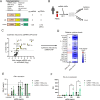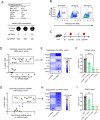Controlling reactogenicity while preserving immunogenicity from a self-amplifying RNA vaccine by modulating nucleocytoplasmic transport
- PMID: 40301369
- PMCID: PMC12041602
- DOI: 10.1038/s41541-025-01135-8
Controlling reactogenicity while preserving immunogenicity from a self-amplifying RNA vaccine by modulating nucleocytoplasmic transport
Erratum in
-
Publisher Correction: Controlling reactogenicity while preserving immunogenicity from a self-amplifying RNA vaccine by modulating nucleocytoplasmic transport.NPJ Vaccines. 2025 Jun 11;10(1):122. doi: 10.1038/s41541-025-01175-0. NPJ Vaccines. 2025. PMID: 40500262 Free PMC article. No abstract available.
Abstract
Self-amplifying RNA (saRNA)-based vaccines have emerged as a potent and durable RNA vaccine platform relative to first generation mRNA vaccines. However, RNA vaccine platforms trigger undesirable side effects at protective doses, underscoring the need for improved tolerability. To address this, we leveraged the Cardiovirus leader protein, which is well-characterized to dampen host innate signaling by modulating nucleocytoplasmic transport (NCT). Co-administration of a leader-protein-encoding mRNA (which we have named "RNAx") delivered alongside vaccine cargo saRNA reduced interferon production while enhancing Influenza hemagglutinin (HA) expression in human primary cells and murine models. RNAx potently decreased serum biomarkers of reactogenicity after immunizations with an HA-expressing saRNA-LNP vaccine while maintaining the magnitude of the antibody and cellular response. RNAx also consistently enhanced binding antibody titers after a single injection and in some conditions enhanced binding antibody and neutralization titers post-boost. These findings support RNAx as a promising platform approach for improving tolerability of saRNA-LNP vaccines while preserving or enhancing immunogenicity.
© 2025. The Author(s).
Conflict of interest statement
Competing interests: The authors declare the following competing interests: All authors currently hold equity in and were employed by ExcepGen Inc. at the time of this study. ExcepGen Inc is an applicant for the following patents, pending in the US and other countries, based on this work. B.M. and T.F. are inventors of WO 2021/055369 for compositions and methods for enhancing protein expression using an NCT inhibitor protein. B.M., T.F., and I.M. are inventors of WO 2022/192694 for compositions and methods for enhancing protein expression using an NCT inhibitor protein. B.M., T.F., and I.M. are inventors of WO 2022/197940 for compositions and methods for vaccines using an NCT inhibitor protein. B.M., T.F., I.M., and J.A.W. are inventors of WO 2023/183889 for compositions and methods for protein expression using RNA encoding an NCT inhibitor protein.
Figures





References
-
- Geall, A. J., Kis, Z. & Ulmer, J. B. Vaccines on demand, part II: future reality. Expert Opin. Drug Discov.18, 119–127 (2023). - PubMed
-
- Oda, Y. et al. 12-month persistence of immune responses to self-amplifying mRNA COVID-19 vaccines: ARCT-154 versus BNT162b2 vaccine. Lancet Infect. Dis.24, e729–e731 (2024). - PubMed
-
- Oda, Y. et al. Immunogenicity and safety of a booster dose of a self-amplifying RNA COVID-19 vaccine (ARCT-154) versus BNT162b2 mRNA COVID-19 vaccine: a double-blind, multicentre, randomised, controlled, phase 3, non-inferiority trial. Lancet Infect. Dis. 24, 351–360 (2023) - PubMed
Grants and funding
LinkOut - more resources
Full Text Sources

